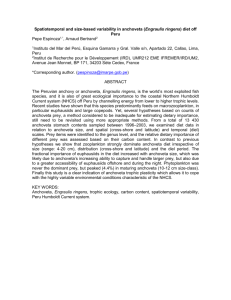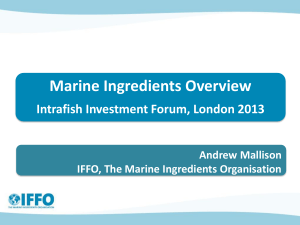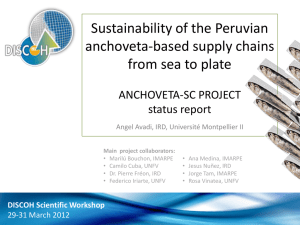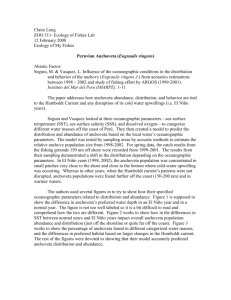VALUE CHAIN ANALYSIS – Anchovy Fisheries in Peru
advertisement
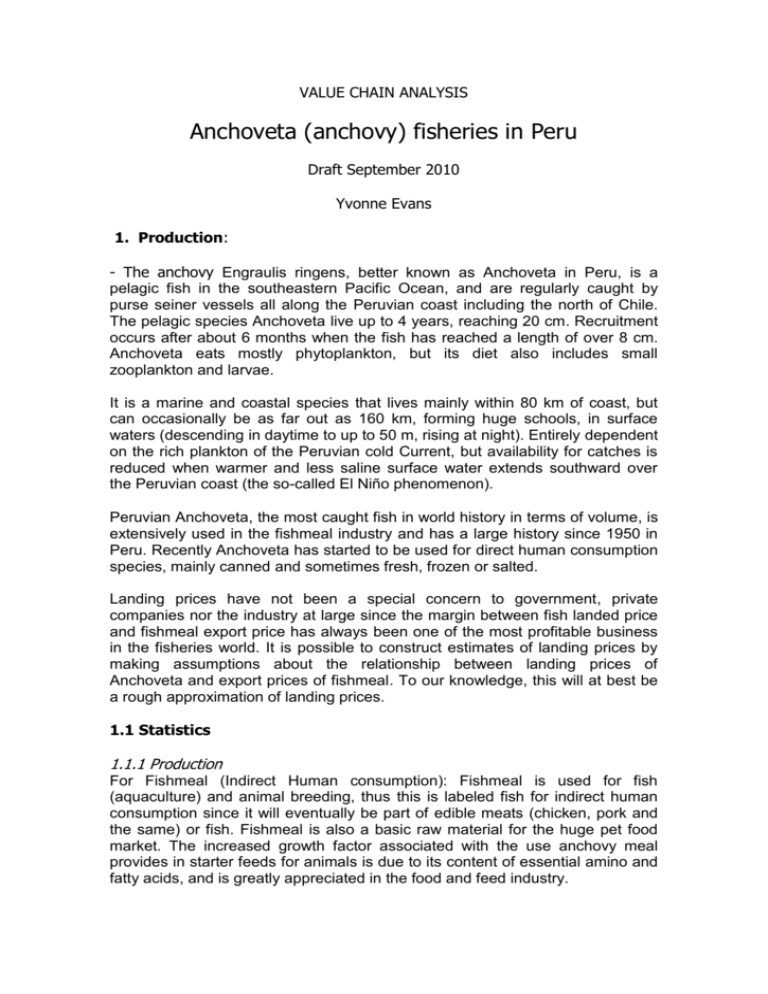
VALUE CHAIN ANALYSIS Anchoveta (anchovy) fisheries in Peru Draft September 2010 Yvonne Evans 1. Production: - The anchovy Engraulis ringens, better known as Anchoveta in Peru, is a pelagic fish in the southeastern Pacific Ocean, and are regularly caught by purse seiner vessels all along the Peruvian coast including the north of Chile. The pelagic species Anchoveta live up to 4 years, reaching 20 cm. Recruitment occurs after about 6 months when the fish has reached a length of over 8 cm. Anchoveta eats mostly phytoplankton, but its diet also includes small zooplankton and larvae. It is a marine and coastal species that lives mainly within 80 km of coast, but can occasionally be as far out as 160 km, forming huge schools, in surface waters (descending in daytime to up to 50 m, rising at night). Entirely dependent on the rich plankton of the Peruvian cold Current, but availability for catches is reduced when warmer and less saline surface water extends southward over the Peruvian coast (the so-called El Niño phenomenon). Peruvian Anchoveta, the most caught fish in world history in terms of volume, is extensively used in the fishmeal industry and has a large history since 1950 in Peru. Recently Anchoveta has started to be used for direct human consumption species, mainly canned and sometimes fresh, frozen or salted. Landing prices have not been a special concern to government, private companies nor the industry at large since the margin between fish landed price and fishmeal export price has always been one of the most profitable business in the fisheries world. It is possible to construct estimates of landing prices by making assumptions about the relationship between landing prices of Anchoveta and export prices of fishmeal. To our knowledge, this will at best be a rough approximation of landing prices. 1.1 Statistics 1.1.1 Production For Fishmeal (Indirect Human consumption): Fishmeal is used for fish (aquaculture) and animal breeding, thus this is labeled fish for indirect human consumption since it will eventually be part of edible meats (chicken, pork and the same) or fish. Fishmeal is also a basic raw material for the huge pet food market. The increased growth factor associated with the use anchovy meal provides in starter feeds for animals is due to its content of essential amino and fatty acids, and is greatly appreciated in the food and feed industry. For Direct Human Consumption: the marketing of Anchoveta for direct human consumption has been proposed in order to fight against starvation and malnutrition, mainly for low income groups in Peru. However, companies also see a pure business opportunity for marketing Anchoveta and the number of Anchoveta products marketed in groceries stores and supermarkets has increased rapidly during the last years. 1.1.2 Prices Fishmeal is exported mainly to China and Europe. Peru is the largest exporting country of fishmeal in the world because of the large Anchoveta fisheries. Export prices are available on monthly and yearly basis through several sources to be crosschecked, such as: Aduanet, Sociedad Nacional de Pesqueria, Ministerio de la Produccion (Produce) and IFFO (OilWorld). For human consumption: as consumption of these products is still at modest level, wholesale local prices are only available from 2007 at Produce (for Minka wholesale local market). Local production prices of Anchoveta products for human consumption are unavailable (canned anchovy in oil or tomato sauce). These are confidential data for producing companies. Retail prices can be collected, but the availability of time series data on retail prices in Peru needs to be explored further. Series on local retail prices not yet published by public organisms, however some export price data could be collected from Peruvian customs webpage. 1.1.3 Employment and income Employment in anchovy fishing involves nearly 40,000 fishermen and additional members of their families. Income: In anchovy fishing large official fishing bans are imposed by the government in order to preserve species. This leads to uneven income flows for fishermen throughout the year, who then have to migrate to other small activities during bans. Peruvian minimum official income is set at USD 160 per month for any labour activity. During the fishing season: this salary rises according to labour demand, fish availability and fishing quotas per vessel. Independent fishermen, i.e. artisanal fishermen, who own their small fishing vessels could gain a revenue about 15% of the current export price of fishmeal, before operational and financial costs have been taken into account. Associations: Federación de Integración y Unificación de Pescadores Artesanales del Perú (FIUPAP), Asociación Nacional de Empresas Pesqueras Artesanales del Perú (ANEPAP) and Asociación de Pescadores del Perú. 2. Processing. - Industrial Products produced: Fishmeal and Fishoil Fishmeal and fish oil are produced by a continuous and carefully controlled process which involves cooking, pressing, drying and milling of fresh, raw fish: anchoveta. Yields of fishmeal and fish oil can vary between fish species and even from season to season, but typically around 17 – 22% fishmeal and 5 – 15% fish oil will be obtained by processing. The following summary provides a step by step guide to production process: 1. Intake: raw fish is sampled and analysed on intake to check for freshness and expected yield of meal and oil. 2. Cooking: the raw fish is conveyed through a steam heated continuous cooker, where it is heated to 90°C-95°C. This sterilizes the fish, coagulates the proteins and disrupts the cell membranes to facilitate the separation of the solubles and the oil from the dry matter. 3. Press: the cooked raw material is fed to a screw press where much of the liquid is squeezed out to form a presscake which is conveyed to the drier. 4. Separator: the press liquid contains water and most of the oil from the fish, as well as dissolved proteins, salts and fine particles. These particles, sometimes called sludge, are removed in a decanter and transported to the drier to be mixed in with the presscake. The liquid from the decanter is fed to separators where the oil is removed and can subsequently be stored in large tanks for export. 5. Evaporator: the water phase from the separators is fed to the evaporators where it is gently concentrated before being blended with the presscake during the drying stage. 6. Drier: the water in the press cake, sludge and concentrate is removed by rapid air drying after which the fishmeal is cooled, milled and stored for export. This method of processing is necessary to obtain marketable products which can be easily stored, transported and utilized. - Products produced (e.g. fresh, salted, dried, canned, refrigerated or frozen) Fresh anchoveta for human consumption: it is becoming more frequent to find some fresh anchoveta at medium to law cost neighbourhood markets. Availability of fresh anchoveta depends on geographical proximity such markets to landing ports, the so called “terminales pesqueros”. Frozen anchoveta is currently processed to become future canned anchoveta in order to ensure availability of fish during bans. This presentation has a foreign demand also. Canned anchoveta is nowadays the most known presentation for human consumption, with three well known brands offering this product in oil, tomato sauce and sometimes with olive oil at some delicatessen rare markets. The canned anchoveta formerly cheap and thought for popular markets is becoming a medium class product due to local marketing places and its profile of export product. Moreover, the Anchoveta only represents approximately 10% of the production costs of the canned product so for this reason cannot be very cheap. - Processing technology (major inputs and costs) Fishmeal and fish oil processing technology currently in Peruvian plants is imported from Norway and some other Scandinavian countries. Purse seiner fishing fleets, some formerly Spanish or Mexican, have been rebuilt into faster and better vessels at Peruvian shipyards with a lot of technical success. - Statistics - Employment in the processing sector As Peruvian processing sector for fishmeal and fish oil is capital intensive it does not need much labour force; moreover, plants are commanded by engineers, some assistants and some workers for general maintenance and security. The key personnel are professionals and chemists at the different lab tasks. Modern canning plants use women for labelling and packaging. - Proportion (quantity) of catch processed in the region Catches are almost entirely used in processing of fishmeal and fish oil and only a small quantity goes to direct human consumption. The capacity of Peruvian plants and Peruvian fishing fleet are larger than current availability of anchoveta, due to the size of the biomass and strict regulation of the fisheries. - Proportion (quantity) sold out of the region or exported for processing Current Peruvian anchoveta catches (quota limit) of 5.8 million tons of raw fish are equivalent to 1.35 million tons of fishmeal and 203 thousand tons of fish oil. All these volumes go to the export market. 3. Transportation - Importance of transportation in the fish supply chain The fishmeal industry is located all along the Peruvian coast. However, the port of export is in Lima, which means that fishmeal has to be transported by land or by sea to Lima before it can be shipped internationally. As anchoveta catches are coastal, processing plants, warehouses, refrigerators, markets and shipping ports are placed very near to the coast. Therefore, truck transportation is the main mean all along the anchoveta supply chain. Inland local markets are not supplied with marine coastal fish as they have own regional river or aquaculture species. - The cost of transportation The average cost of truck transportation in Peru is at..................... - Changes in transportation cost over time Transportation costs may vary according to season (wet or dry). El Niños which can involve heavy rains can disrupt road infrastructure and therefore increase the cost of transportation. - Transportation a public or private business matter? Currently all Peruvian transportation is a private business matter with corresponding regulations given by the government. 4. Final consumption. - Statistics - Portion (quantity) of the product sold domestically and exported - Types of products sold in the different markets. 5. Regulations. Fisheries is currently regulated with closed fishing seasons (Vedas) and individual transferable quotas (ITQs). Transferability of quotas is still restricted. Although the ITQ system was introduced recently in Peru, it already seems to had an impact in reducing fishing fleet capacity and extending the fishing season. There have been complaints about the system favouring large operators. There 6. Market structure. The fishmeal industry has consolidated and currently there are 58 companies that participate in exports of fishmeal and fish oil. The largest companies include TASA, Corporación Pesquera Inca, Pesquera Hayduk, Austral Group Pesquera Industrial El Ángel and Pesquera Diamante. Based on exports volumes, the four-firm concentration ratio is around 50%. In terms of international fishmeal and fish oil prices there is little reason to believe that these companies exert much influence in terms of market power. Several of these companies participate in the market of Anchoveta products for human consumption, basically canned products. This is a market that consists of several competing brands based on Anchoveta and other anchovies/sardines species. There are also exports of these products to few countries such as Colombia and Brazil. 7. Data availability. The length of time series at the different stages for anchoveta for indirect human consumption could go from 2003 to 2009 or half 2010. However, while volume figures are readily available for all stages in the supply chain, price data are mainly available for traded fish. The length of time series at the different stages for anchoveta for direct human consumption could go from 2007 to 2009 or half 2010. Monthly frequency is to be calculated. The short length of this series is due to its new market profile.
